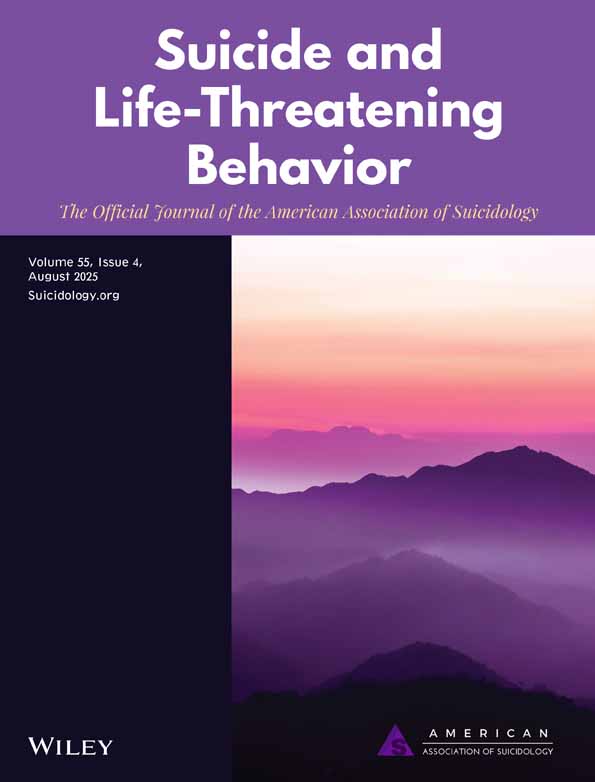Interpersonal Problem-Solving Skills Training in the Treatment of Self-Poisoning Patients
Abstract
The present study evaluated the effectiveness of interpersonal problem-solving skills training (IPSST) for the treatment of self-poisoning patients. Thirty-nine self-poisoning patients were assigned randomly either to IPSST or to a control treatment condition (a brief problem-oriented approach). Both conditions were equally effective in reducing the number of presenting problems and in reducing hopelessness levels. However, the IPSST condition was significantly more effective than the control condition as determined by other outcome measures (measures of interpersonal cognitive problem solving, self-rated personal problem-solving ability, perceived ability to cope with ongoing problems, and self-perception). Follow-up studies showed maintenance of IPSST treatment gains at 6 months and a greater reduction of repetition of self-poisoning in the IPSST group at 1 year posttreatment.
Studies into the circumstances associated with self-poisoning behavior have consistently highlighted the existence of interpersonal conflict in the lives of self-poisoning patients, in terms of both chronic relationship problems and acute conflict situations in the hours preceding self-poisoning episodes (Adam, Bianchi, Hawker, Nairn, Sanford, & Scarr, 1978; Bancroft, Skrimshire, Casson, Harvard-Watts, & Reynolds, 1977; Birtchnell, 1981; Cochrane & Robertson, 1975; Fieldsend & Lowenstein, 1981; Jacobson & Tribe, 1972; Kreitman, 1970; Morgan, Burns-Cox, Pocock, & Pottle, 1975; Smith & Davison, 1971; Pallis, 1977; Parker, 1981; Paykel Prusoff, & Myers, 1975; Werry & Pedder, 1976). The capacity to exercise good interpersonal problem solving has become a focus of interest for research with this population (Clum, Patsiokas, & Luscomb, 1979; McLeavey, Daly, Murray, O'Riordan, & Taylor, 1987; Schotte & Clum, 1982). Clum et al. (1979) proposed a model of suicidal behavior whereby the relation between life stress and suicidal behavior is mediated by cognitive rigidity. The model proposes that when individuals who are deficient in the capacity for flexible divergent thinking are placed under conditions of high life stress, they are unable to cope effectively, become hopeless, and are, consequently, at heightened risk for suicidal behavior. Schotte and Clum (1987) found some support for the model in a study of problem-solving skills in suicidal psychiatric patients, who were found to be deficient in their ability to generate alternative solutions to interpersonal problems, as well as to anticipate negative consequences for proposed solutions, when compared with nonsuicidal psychiatric controls. However, the majority of their subjects (85%) were hospitalized with a diagnosis of schizophrenia, a proportion considerably higher than that found in the self-poisoning population (Morgan et al., 1975; Newson-Smith & Hirsch, 1979; Urwin & Gibbons, 1979). A problem-solving ap proach in the treatment of suicide ideators (Lerner & Clum, 1990) was more effective than supportive therapy in reducing depression, hopelessness, and loneliness at 3-month follow-up, but both conditions were equally effective in reducing suicidal ideations. Linehan, Armstrong, Suarez, Allmon, and Heard (1991) compared a cognitive-behavioral therapy (dialectical behavior therapy) with a control condition (“treatment as usual” in the community) for the treatment of chronically parasuicidal borderline patients. At most assessment points over the treatment period of 1 year, the subjects who received dialectical behavior therapy had fewer incidences of parasuicide and less medically severe parasiticides, were more likely to stay in individual therapy, and had fewer inpatient psychiatric days. There were no differences between groups on measures of depression, hopelessness, suicide ideation, or reasons for living, although reduction on all four measures was found.
McLeavey et al. (1987) compared the interpersonal problem-solving skills of self-poisoning patients with those of psychiatric patients and nonpatient controls, and found that the self-poisoning group were more deficient than psychiatric patients, who in turn were less effective problem-solvers than the nonpatient controls. The self-poisoning patients showed significant deficits in their ability to conceptualize the means to solve problems, in their ability to generate alternative courses of action, in their sensitivity to consequences in human behavior, and in their responses to their own everyday interpersonal problems. These findings were considered of major importance in the planning of any intervention program for self-poisoning and formed the basis for the present study into the effectiveness of a program of interpersonal problem-solving skills training.
The present study was limited to self-poisoning patients because self-poisoning, the most common form of parasuicide, has been distinguished from deliberate self-injury, and from combined self-poisoning and self-injury, by a number of authors (Bancroft, Hawton, Simkin, Kingston, Cumming, & Whitwell, 1979; Kessel, 1965; Newson-Smith & Hirsch, 1979; Prescott & Highly, 1985; Urwin & Gibbons, 1979). Hawton and Catalan (1982) point out that in many cases self-cutting (the most common form of deliberate self-injury) appears to be a different phenomenon in psychopathological terms from self-poisoning and may, therefore, carry different requirements for treatment, aftercare, and prevention.
METHOD
Subjects
The subjects were 39 patients admitted to the Casualty Department of Cork Regional Hospital following self-poisoning. Only subjects who completed treatment with full pre- and posttreatment assessments were included. Patients were referred to the study by the liaison psychiatrist if they met the following criteria:
- 1
Age in the range of 15–45 years.
- 2
No history of psychosis, mental retardation, or organic cognitive impairment.
- 3
The self-poisoning was intentional.
- 4
The patient did not need psychiatric hospital inpatient or day-patient care because of psychiatric illness and/or suicidal risk.
Patients were admitted to the study if, in addition to the above criteria, they attained an IQ score of at least 80 on the Mill Hill Vocabulary Scale (Raven, 1965).
Over the period of the treatment study a total of 91 patients met the inclusion criteria. Of these, 39 completed treatment with full pre- and posttreatment assessments. Thirty-four patients either refused treatment or did not keep the preassessment appointment, and 7 patients defaulted after preassessment. There were no significant differences between completers and nonattenders with regard to sex or age. A higher number of nonattenders were given a diagnosis of alcohol abuse, but there were no other significant differences on psychiatric diagnosis. The nonattendance rate is similar to nonattendance rates previously reported for parasuicide patients referred to outpatient clinics (Blake & Mitchell, 1978; Chowdhury, Hicks, & Kreitman, 1973; Kreitman, 1977; 1979; Taylor & Stansfeld, 1984). Five patients dropped out of treatment before completion (3 control group subjects and 2 IPSST group subjects), and 6 subjects did not participate in post-assessment (4 control group and 2 IPSST group subjects).
Patients were assigned on a random basis to the two treatment conditions: interpersonal problem-solving skills training (IPSST) or control. Table 1 summarizes the relevant characteristics of the two groups.
| Age | IQ | ||||||
|---|---|---|---|---|---|---|---|
| n | Sex | Mean | SD | Mean | SD | Occupation | |
| IPSST group | 19 | F = 15 | 23.58 | 5.98 | 94.84 | 5.32 | Unemployed = 7 |
| M = 4 | Skilled manual = 5 | ||||||
| Student = 3 | |||||||
| Housewife = 4 | |||||||
| Control group | 20 | F = 14 | 25.25 | 8.09 | 93.80 | 4.54 | Unemployed = 6 |
| M = 6 | Skilled manual = 6 | ||||||
| Office Work = 1 | |||||||
| Student = 4 | |||||||
| Housewife = 3 | |||||||
There was no significant difference between the two groups in terms of age (df = 37, t = 1.02, NS) or in terms of IQ (df = 37, t = 0.66, NS). The groups were also similar with regard to occupation. Of the IPSST subjects, 47%; and of the control group subjects, 25% had a history of previous self-poisoning episodes.
Table 2 summarizes the psychiatric status of the two groups.
| Number of subjects | ||
|---|---|---|
| Diagnosis | IPSST group | Control group |
| Dysthymia | 4 | 5 |
| Dependent personality disorder | 3 | 3 |
| Alcohol abuse | 3 | 2 |
| Other | 1b | 1c |
| No diagnosis | 8 | 9 |
- aBased on the Diagnostic and Statistical Manual of Mental Disorders (3rd ed., rev.). Washington, DC: American Psychiatric Association, 1987.
- bEpilepsy.
- cPanic disorder.
Outcome Measures
Repetition of self-poisoning has been considered a relatively insensitive and possibly misleading indicator of outcome (Kreitman, 1979). Outcome was, therefore, evaluated by multiple assessments pre- and posttreatment.
Measures of Interpersonal Cognitive Problem Solving
Three measures of interpersonal cognitive problem solving (ICPS) were used (Platt & Spivack, 1977):
- 1
Means-Ends Problem-Solving (MEPS) Procedure: This procedure, using a series of story stems, assesses social means-ends thinking by requiring the subject to provide appropriate, effective means to reach a stated goal. Eight story stems were used, four pretreatment and four posttreatment. The total number of means for the four stories, pre- and posttreatment, was scored for each subject.
- 2
The Optional Thinking Test: This task requires the subject to generate alternative possibilities for overcoming hypothetical real-life interpersonal problems. Two problems were presented pretreatment and two posttreatment. The total number of relevant options was scored, pre- and posttreatment, for each subject.
- 3
The Awareness of Consequences Test: This test assesses the subject's tendency to:
- a.
Consider the possibility of transgressing when faced with a temptation and
- b.
Weigh the pros and cons prior to making a decision
The scores for both aspects were combined, allowing for a maximum possible score of 4 for two temptation stories presented at pretest, and similarly for those presented posttreatment.
Self-Rating Problem-Solving Scale (SRPS Scale) This 25-item Likert-type scale was designed and developed to measure attitudes and responses to the individual's own everyday interpersonal problems (McLeavey, Daly, Murray, O'Riordan, & Taylor, 1987).
Self-Perception Scale Self-concept was assessed using a modified version of the Miskimins Self-Goal-Other Discrepancy Scale (MSGO — Miskimins, 1979; Miskimins & Braucht, 1976), which is a specific self-concept scale with demonstrated reliability and validity. Both self and ideal-self components were assessed, allowing for examination of changes in self-ideal-self discrepancy. Two separate forms, (1) Me — As I Am, and (2) Me — As I Would Like to Be, were designed, using for each form the same 15 adjective pairs on 7-point bipolar scales.
Problems Questionnaire This questionnaire was designed to obtain two measures relating to the subject's current problems: (1) the number of problems at the time of testing and (2) the subject's perceived ability to resolve these problems, measured by requiring the subject to rate, on a 5-point scale, how difficult he/she felt it would be to solve each of the problems enumerated.
Hopelessness Scale Beck, Weissman, Lester, and Trexler's (1974) instrument was used.
Follow-up Measures
At 6 months posttreatment a follow-up assessment was carried out using the SRPS Scale, the Self-Perception Scale, and the Hopelessness Scale.
Repetition of self-poisoning was checked after 1 year posttreatment. A questionnaire was sent to the General Practitioner of each patient who completed treatment, requesting information on any subsequent self-poisoning episode. This information was supplemented by inspection of hospital records.
Procedure
Each patient who met the inclusion criteria was interviewed as soon as he/she was considered by the medical team to be fit for discharge from the Casualty Department. The nature of the study was outlined and each patient who agreed to participate was returned for pretesting within 3 days of discharge, and for random allocation to either of the treatment conditions. Each patient who completed a treatment program was posttested 2 to 3 weeks after the completion of treatment. Follow-up, at 6 months, was conducted by post in order to ensure the highest possible response rate.
An independent assessor, blind to the treatment conditions in which the patients had participated, administered both pretreatment and posttreatment measures.
Treatment Conditions
Interpersonal Problem-Solving Skills Training A detailed Manual for interpersonal problem-solving skills training (IPSST-McLeavey & Daly, 1988) was compiled for the training program, with a supplementary Workbook used by patients for homework assignments (McLeavey & Daly, 1988).1
The program was administered individually and was made up of 5 60-minute sessions (or 6 sessions if extra time was needed), held at intervals of 1 week.
For the purpose of training, the five general stages of problem solving, as proposed by D'Zurilla and Goldfried (1971) were adhered to, utilizing their recommended procedure of progressive training in the various stages of problem solving. Instruction, active discussion, and reflective listening were the principal training techniques. Additional techniques included modeling (Bandura, 1974; Kazdin, 1974a, 1974b, 1974c; Meichembaum, 1971), using a “coping” rather than a “mastery” model strategy (Spiegler, Liebert, McMains, & Fernandez, 1969) as recommended by Mahoney (1977); role playing (Priestly, McGuire, Flegg, Hemsley, & Welham, 1978); sentence completion (Goldfried, 1979); and prompting (D'Zurilla and Goldfried, 1971).
Control Condition The control condition was a brief problem-oriented approach. This was similar to the IPSST program in the following respects:
- 1
Treatment was conducted on an individual, one-to-one basis.
- 2
Patients were seen for the first session within 2 weeks of discharge from the Casualty Department.
The main focus was on the patient's current problems, which he/she was helped to solve in a practical, commonsense manner. The patient was also helped to gain some insight into his/her problems as a preventive measure. Treatment was terminated when presenting problems were satisfactorily resolved.
The control condition did not involve specific skills training. This approach was based largely on the principles of crisis intervention (Hawton & Catalan, 1982). The primary goal was resolution or reduction of current problems, which is achieved by helping the patient to solve current problems, by discussion, in a commonsense manner. A secondary aim, anticipated to occur as a consequence of the treatment process, was to effect change in ability to cope with future problematic situations. In contrast, the primary goal for the IPSST condition was improvement in problem-solving ability, which is achieved by the acquisition or enhancement of basic problem-solving skills through a skills-training program.
Treatment conditions were monitored by strict adherence to the treatment Manual (IPSST condition) and by inspection of session records (both conditions) by an independent (trained) research assistant.
Therapists
The therapists were clinical psychologists and registrars in psychiatry employed in the Professorial Psychiatric Unit of Cork Regional Hospital. All therapists had extensive experience in the assessment and treatment of self-poisoning patients.
Treatment Sessions
The mean number of sessions held with subjects who completed the IPSST treatment program was 5.3 (SD = 0.48). For those who completed the control treatment, the mean number of sessions was 4.2 (SD = 1.32). The difference between the groups, in terms of the number of sessions, was not significant (U = 24, p > .05).
RESULTS
Pretest Group Equivalence
The two groups did not differ significantly on any of the measures used at pretest and were, therefore, considered equivalent at pretesting.
Treatment Effects
The mean scores, for both treatment groups, on pretest and posttest measures, are plotted in 1-8. Means for the “normal” population are included, where available, for comparative purposes, as recommended by Rhem, Fuchs, Roth, Kornblith, and Romano (1979) and by Kendall and Norton-Ford (1982). The means and normal ranges for ICPS measures, the SRPS Scale, and the Self-Perception Scale were based on data obtained in an earlier study (McLeavey et al., 1987), using nonpatient groups of subjects. The normal range for the Hopelessness Scale was based on Greene's (1981) normative data for the general Irish population.

Mean group scores on MEPS at pretest and posttest.
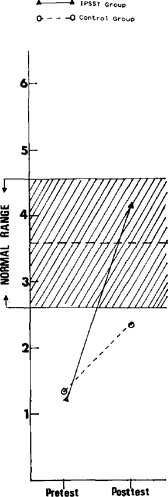
Mean group scores on Optional Thinking at pretest and posttest.
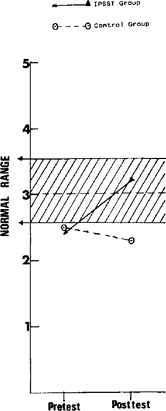
Mean group scores on Awareness of Consequences at pretest and posttest.

Mean group scores on SRPS Scale at pretest and posttest.
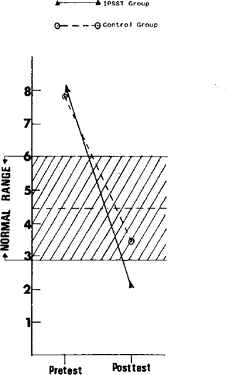
Mean group scores on the Hopelessness Scale at pretest and posttest.

Mean group scores on the Self-Perception Scale at pretest and posttest.
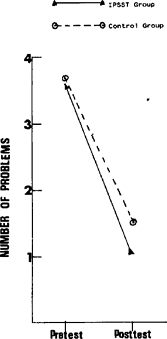
Mean group scores on Number of Problems at pretest and posttest.

Mean group scores on Perceived Ability to Solve Current Problems at pretest and posttest. (Lower scores indicate increased confidence in ability to solve problems.)
A pretest-posttest (change) design was used to assess differential treatment effects (Kazdin, 1980; Kraemer, 1981). The results of these tests are presented in Tables 3 and 4.
| IPSST group | Control group | |||||
|---|---|---|---|---|---|---|
| Measure | Mean Change Score | SD | Mean Change Score | SD | U | Significance |
| MEPS | 4.26 | 2.10 | 0.47 | 1.10 | 10.50 | p < .01 |
| Optional Thinking | 3.00 | 0.94 | 1.05 | 1.23 | 8.00 | p < .01 |
| Awareness of Consequences | 0.89 | 1.54 | 0.05 | 0.89 | 116.50 | p < .05 |
| Number of Problems | 2.42 | 1.46 | 1.60 | 2.19 | 146.00 | NS |
| Perceived Ability to Solve Current Problems | 2.03 | 0.85 | 0.98 | 1.43 | 90.50 | p < .05 |
| IPSST group | Control group | ||||
|---|---|---|---|---|---|
| Measure | Mean Change Score | SD | Mean Change Score | SD | t |
| SRPS Scale | 20.68 | 10.50 | 6.10 | 6.92 | 5.21* |
| Hopelessness Scale | 6.12 | 4.61 | 4.35 | 4.39 | 1.25 |
| Self-Perception Scale | 16.32 | 11.13 | 4.20 | 6.24 | 4.29* |
- *p < .01.
Treatment outcome was considered in terms of both statistical significance and clinical significance (the meaningfulness of the magnitude of change, or the remediation of the presenting problem to the point that it is no longer troublesome — Kendall & Norton-Ford, 1982).
Statistical Significance On measures of Interpersonal Cognitive Problem-Solving Skills the gains made by the IPSST group were significantly greater than those of the control group on MEPS, Optional Thinking, and Awareness of Consequences.
The two groups did not differ significantly in the mean change in the Number of Current Problems reported from pretest to posttest. On Perceived Ability to Resolve Current Problems, however, the IPSST group made a significantly greater improvement.
On the SRPS Scale the mean change score for the IPSST group was significantly greater than that for the control group.
The difference between the groups in their mean change scores on the Hopelessness Scale did not reach statistical significance.
The improvement in scores on the Self-Perception Scale was significantly greater for the IPSST group.
Clinical Significance Normative comparisons were made across outcome measures by comparing group scores with the “normal” range on the basis of (1) the means for both treatment groups pre- and posttreatment, and (2) the percentage of subjects reaching the criterion of clinical significance (i.e., scoring within the normal range at posttest).
At pretest the mean score for both groups on Means-Ends Problem Solving fell more than 1 SD below the normal mean. At posttest the IPSST group mean was well within the normal range (Fig. 1), and 68% of the subjects reached the criterion of clinical significance. The mean score for the control group at posttest remained more than 1 SD below the normal mean, with 20% of the subjects within the normal range.
At pretest, on Optional Thinking, both groups also obtained a mean score of more than 1 SD below the normal mean. At posttest, the IPSST group mean was above the normal mean (Fig. 2), and 95% of subjects scored within the normal range. The mean score for the control group at posttest remained outside the normal range. Fifty-five percent of subjects reached the criterion of clinical significance.
On Awareness of Consequences, both group means were very close to the normal range at pretest (Fig. 3), suggesting that this measure is less sensitive than the other two ICPS measures to the problem-solving deficits of self-poisoning patients. At posttest the IPSST group mean was above the normal mean, with 79% of subjects within the normal range. The control group mean remained outside the normal range at posttest. Forty-seven percent of these subjects scored within the normal range.
On the SRPS Scale, both group means, at pretest, were more than 1 SD below the normal mean. At posttest the IPSST group mean was above the normal mean (Fig. 4), with 68% of subjects within the normal range. The control group mean at posttest was again more than 1 SD below the normal mean, with 25% of the subjects scoring within the normal range.
Both group means on the Hopelessness Scale were more than 1 SD above the normal mean at pretest. While the IPSST group mean, at posttest, was below the normal mean, the control group mean was also well within the normal range (Fig. 5). Of IPSST group subjects, 100; and of control group subjects, 80% were within the normal range at posttest.
The IPSST group made statistically significantly greater gains, from pretest to posttest, in reducing self-ideal-self discrepancy (Self-Perception Scale; Fig. 6). However, the control group mean was close to the normal range at posttest: 100% of IPSST group subjects and 70% of control group subjects scored within the normal range.
Follow-up
The number of subjects who participated in follow-up was 17 for the IPSST group and 16 for the control group. The maintenance of treatment gains was measured by a pretreatment-follow-up change de sign. Mean change scores and standard deviations for both groups are presented in Table 5.
| IPSST group | Control group | ||||
|---|---|---|---|---|---|
| Measure | Mean | SD | Mean | SD | t |
| SRPS Scale | 20.59 | 14.07 | 3.56 | 10.55 | 3.93* |
| Hopelessness Scale | 4.94 | 8.38 | 4.44 | 6.21 | 0.19 |
| Self-Perception Scale | 16.06 | 11.69 | 4.38 | 6.24 | 3.57* |
- *p < .01.
On the SRPS Scale the difference between the two treatment groups at follow-up was again statistically significant. In terms of clinical significance, the IPSST group maintained the gain found at posttreatment. The control group follow-up mean was again more than 1 SD below the normal mean.
On the Hopelessness Scale the difference between the two groups did not reach statistical significance. In terms of clinical significance, both group follow-up means were well within the normal range. The gains made by both groups at post-test were, therefore, maintained at 6-month follow-up.
The difference between the two groups on the Self-Perception Scale was statistically significant. Both group means did, however, reach the criterion of clinical significance. These findings were very similar to those of the posttreatment assessment. The marked gain made by the IPSST group at posttest was maintained at 6-month follow-up.
Repetition
The self-poisoning act was repeated within 1 year by 10.5% of the subjects in the IPSST group, and by 25% of the subjects in the control group.
DISCUSSION
The results of this study indicate that training self-poisoning patients in interpersonal problem-solving skills is effective in significantly enhancing these skills to a level well within the normal range. In addition, it is effective in significantly increasing ability to cope with personal everyday problematic situations. The comparative treatment, a problem-oriented approach, was significantly less effective than the skills-training approach on measures of means-ends problem solving, optional thinking, and consequential thinking. Both methods were successful in reducing the number of problems presenting at intake and in reducing hopelessness levels, but the skills-training program was more effective in enhancing subjects' perceived competence in problem-solving ability.
A number of studies have found that the reasons offered by patients for their self-poisoning attempt differ from the reasons attributed by psychiatrists and by significant others in the proportion of attempts rated as a wish to die. Adam et al. (1978) suggested that this was the primary aim in only 13% of cases. However, substantial agreement between patients and others has been found regarding the high proportion intending to communicate with or to influence others, in the frequency of inability to find alternative strategies for dealing with an “unbearable” situation, and seeking of relief or escape (Bancroft et al., 1979; Bancroft & Hawton, 1983; Hawton & Catalan, 1982; James & Hawton, 1985; Parker, 1981). Findings regarding motivational aspects are congruent with the types of problems that have been found to be associated with self-poisoning. The most common problem, reported consistently across studies of self-poisoning, is interpersonal conflict between the patient and a key individual in his/her life: spouse, cohabitee, parent/child, or boy- or girlfriend. Quarrels commonly precede a self-poisoning act, and these quarrels are frequently embedded in chronic relationship difficulties. The significant changes in interpersonal problem-solving competence evidenced in the IPSST group would seem to be highly important in relation to the most common problem associated with self-poisoning, that is, stressful interpersonal relations and events.
The greater reduction in the magnitude of the self-ideal-self discrepancy evidenced by the IPSST group may be a function of a greater enhancement of a “coping” self-image. Ryan, Krall, and Hodges (1976) found that two behavioral methods (systematic desensitization versus relaxation training only) used in the treatment of test-anxious subjects were effective in reducing test anxiety, and subjects' ratings of satisfaction with treatment were equivalent in the two conditions. However, significant positive changes in self-concept were found in the desensitization group only, and the authors hypothesized that the differential effectiveness of the treatments on self-concept was a function of the beneficial effects of imagined successful coping in the desensitization procedure. Self-concept changes may also have important consequences for maintaining and extending the effects of treatment. At follow-up, the marked gains made by the IPSST group in the present study were maintained at 6 months post-treatment. Lazarus (1966) has implicated self-concept changes in the successful maintenance and extension of gains in therapy. In reviewing his previous clients, he concluded that those for whom gains were best maintained were the ones who had evidenced increased self-esteem in addition to the increased range of interpersonal and behavioral skills.
Because of the relatively low base rate for repetition of self-poisoning (15–25%), the number of subjects in the present study was not sufficiently large to enable conclusive interpretation regarding the efficacy of interpersonal problem-solving skills training in reducing the self-poisoning repetition rate. However, results are indicative that this approach is effective. One year posttreatment the repetition rate for the control group (25% of subjects had repeated) was consistent with the base rate, and with the report of most investigators and reviews of various forms of treatment on the reduction of the repetition rate (Chowdhury et al., 1973; Ettlinger, 1975; Gibbons, 1980; Gibbons, Butler, Urwin, & Gibbons, 1978; Goldney & Burvill, 1980; Greer & Bagley, 1971; Hawton & Catalan, 1981; Kreitman, 1977; Williams, 1985). In the IPSST condition, on the other hand, 10.5% of the subjects had repeated within 1 year. The clinical significance of this finding is further strengthened by the previous history of self-poisoning for both groups, before commencement of treatment. Of the IPSST group, 47%; and of the control group, 25% had a history of one or more previous attempts. Because a history of previous attempts increases the risk of future attempts (Buglass & Horton, 1974; Greer & Bagley, 1971), the IPSST group contained more subjects at higher risk of repetition than the control group. Further studies using larger sample sizes will be necessary to draw firm conclusions regarding the view that this form of intervention has a significant effect on repetition rates.
The self-poisoning patients selected for the present study were relatively low in lethality (i.e., did not require inpatient or day-patient hospital treatment), in an effort to avoid confounding the IPSST condition with other forms of psychotherapy. Further research will be required to determine whether this approach is also effective in the treatment of higher-lethality patients.



